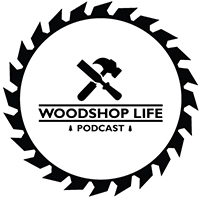Brian’s Questions:
Hey Fellas,
I’m in the market for a new table saw. I am coming from a 2hp Grizzly hybrid saw with a broken part I cannot find a replacement for. I’m debating between a 3hp Powermatic or Sawstop. Either of these will be a major upgrade from what I have but do you have opinions either way? The Sawstop technology is great and I understand accidents can happen but I tend to think if your hands are that close to the blade you’ve got bigger problems. That said, the Sawstop is up to $1,000 cheaper than the powermatic depending which add-ons you choose. Do you have any thoughts or are there other brands I’m missing and should look into?
Chris
Instagram: @custom_by_chris
Hi guys! I am a hobbyist/turning professional woodworker based in Portland, Oregon. I have really enjoyed listening to your podcast and thought I would quickly ask your opinion on rectangular dominos.
I have been creating shop-made dominos to save money. Creating them is a pain in the butt! Trying to nail metric round-overs with imperial bits at that level of precision is pretty involved. It usually takes a bit of time and wasted material to set the router table up correctly in order to batch a bunch out. Then running a glue groove on everything is another step that takes time. A thought came to me about creating square edged, rectangular tenons that aren’t hitting the radii of the domino mortise. My thought is that the few millimeters of void wouldn’t really affect the strength of the joint and the voids themselves would act as a hydrolock prevention by nature. Assuming these aren’t used for through style tenons, do you see any issues using rectangular stock? Thanks for doing the podcast and I look forward to future episodes!
Sal Al-Sudairy
sfapdx@gmail.com
@oregon_woodworks Instagram
Guy’s Questions:
Hey Guy’s
I know finishing gets hit often but this is perhaps a different spin. My basement garage is my workshop so odor and chemical safety is a concern.
I’m mostly done with my plywood/poplar painted dresser (thanks for the tips by the way, screwing and glueing without fancy jointery made assembly a breeze Guy).
That being said what is a good low odor option for finishing a paint grade project that’s being painted white? Yellowing and tannin bleed are therefore both concerns.
I’ve heard Ya’ll talk about conversion varnishes but also heard complaints about odor. Would BIN water based primer under enamel paint be best? Should I go the oil based primer/paint route for durability?
I have recently gotten a paint sprayer but am open to rolling if that’s preferable. I’ll attach my budget sprayer below for context.
Thanks so much, this is by far the best woodworking podcast.
-Dave
Hello Huy, Guy, and Brian! You gentlemen, as well as Sean, have been a huge help and inspiration to my woodworking journey. Keep the great content coming!
I recently picked up an older Bosch 1615 evs plunge router mounted to an old tabletop with an Incra Intelli fence. While I can find manuals online for both of these discontinued items, I’d like to get your input on how to best set up an older router with this fence. Since this particular router is in its own molded housing, I don’t think a router lift is an option. What do you all recommend for setting this router up in a new table? I intend to likely build a stand-alone router table with a top made with melamine left over from a recent project, but I’m open to suggestions. Thanks, -Kurt
Huy’s Questions:
Hi everyone,
Thank you for a great show. I’ve listened through the entire catalog twice, learning a lot.
In Episode #115 (and other episodes) you mention UV light turning walnut orange. I recently built a large dining room table out of walnut. I did not dye the table, even though I knew color change was possible. I have never used dye and the walnut was so stunning, I was afraid I would mess it up.
If my table turns orange, can it be sanded off? How deep does the UV “damage” go into the wood?
If I was to dye the walnut, could you please remind us what color dye you have used that works on walnut? How you have applied it to walnut, and when in the finishing process?
hanks again for a great show and a great woodworking education.
Kevin
Hello Gentleman,
Love the podcast. Thanks for all your hard work.
I am considering tackling a Entertainment unit for my bonus room; however I am struggling with material choice. The cabinet finish will be painted, do you suggest plywood or MDF? I plan on building some drawers with plywood boxes and MDF faces but I am concerned about the durability of the MDF when installing hinges if I use it for the carcass construction.
The overall length of this build is 16″ long by 8′ tall with drawers along the bottom open shelving on either side of that with the TV in the middle. Normally I am not so indecisive ; however this is such a large project and with the high cost of materials I want to start off on the right foot. Any guidance would be appreciated.
- Mike
